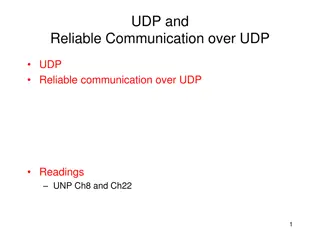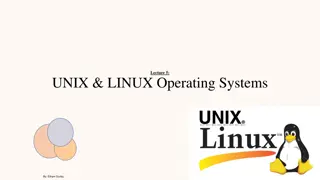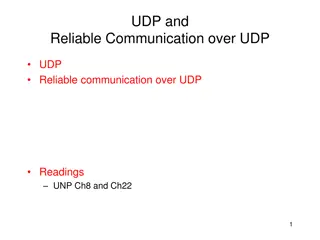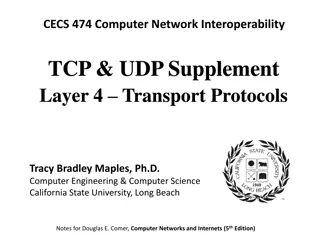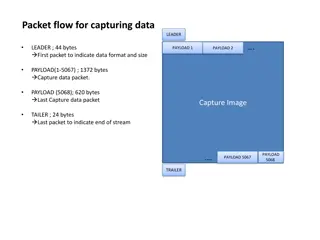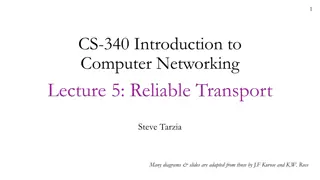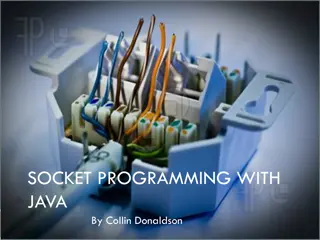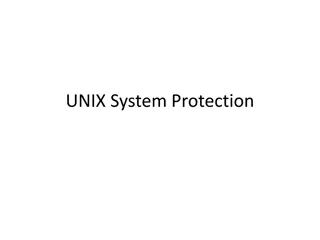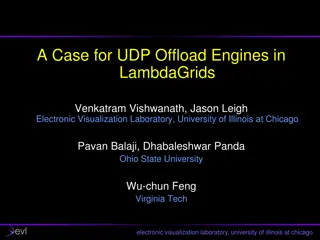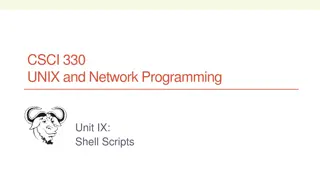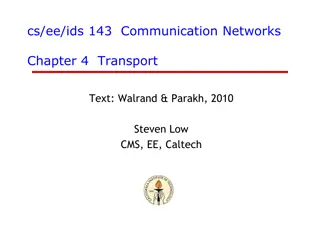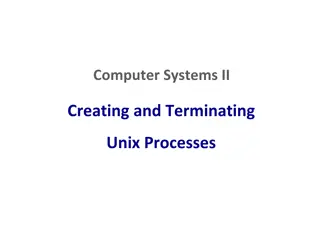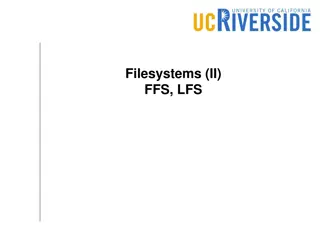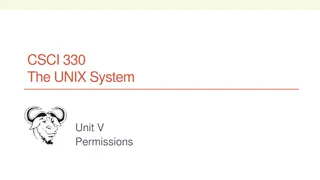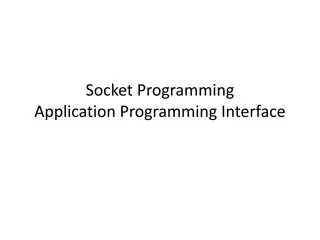Understanding User Datagram Protocol (UDP) in Unix and Network Programming
Explore the fundamentals of User Datagram Protocol (UDP) in Unix and Network Programming, covering topics such as UDP client/server programs, network layers, transport layer services, UDP packet format, and socket programming. Learn about the characteristics and usage of UDP, including its simple message-based, connection-less nature and its role as a fast, stateless protocol for transmitting data between hosts.
Download Presentation

Please find below an Image/Link to download the presentation.
The content on the website is provided AS IS for your information and personal use only. It may not be sold, licensed, or shared on other websites without obtaining consent from the author. Download presentation by click this link. If you encounter any issues during the download, it is possible that the publisher has removed the file from their server.
E N D
Presentation Transcript
CSCI 330 UNIX and Network Programming Unit XIV: User Datagram Protocol
CSCI 330 - UNIX and Newtork Programming 2 Unit Overview Transport layer User datagram protocol UDP programming Example UDP client/server programs
CSCI 330 - UNIX and Newtork Programming 3 Review: Network Layer also called: Internet Protocol (IP) Layer provides host to host transmission service, where hosts are not necessarily adjacent IP layer provides services: addressing hosts have global addresses: IPv4, IPv6 routing and forwarding find path from host to host
CSCI 330 - UNIX and Newtork Programming 4 Transport Layer provides end-to-end communication services for applications provides multiple endpoints on a single node: port TCP: transmission control protocol connection oriented, guaranteed delivery stream oriented: UDP: user datagram protocol best effort datagram oriented: basis for: http, ftp, smtp, ssh basis for: dns, rtp
CSCI 330 - UNIX and Newtork Programming 5 UDP simple message-based connection-less protocol transmits information in one direction from source to destination without verifying the readiness or state of the receiver uses datagram as message stateless and fast
CSCI 330 - UNIX and Newtork Programming 6 UPD packet format bits 0 32 64 96 128 0 7 8 15 Source IP address Destination IP address Protocol Source Port Length 16 23 24 31 Zeros UDP length Destination Port Checksum 160+ Data
CSCI 330 - UNIX and Newtork Programming 7 UDP programming common abstraction: socket first introduced in BSD Unix in 1981 socket is end-point of communication link identified as IP address + port number can receive data can send data
CSCI 330 - UNIX and Newtork Programming 8 Socket system calls client server System call Meaning socket Create a new communication endpoint bind Attach a local address to a socket optional sendto Send(write) some data over the connection recvfrom Receive(read) some data over the connection close Release the connection
CSCI 330 - UNIX and Newtork Programming 9 UDP communications pattern optional
CSCI 330 - UNIX and Newtork Programming 10 System call: socket
CSCI 330 - UNIX and Newtork Programming 11 System call: socket int socket(int domain, int type, int protocol) creates a new socket, as end point to a communications link domain is set to AF_INET type is set to SOCK_DGRAM for datagrams protocol is set to 0, i.e. default UDP returns socket descriptor: used in bind, sendto, recvfrom, close
CSCI 330 - UNIX and Newtork Programming 12 System call: bind
CSCI 330 - UNIX and Newtork Programming 13 System call: bind int bind(int sockfd, const struct sockaddr *addr, socklen_t addrlen) assigns address to socket: IP number and port struct sockaddrholds address information will accept struct sockaddr_inpointer addrlen specifies length of addr structure returns 0 on success, -1 otherwise
CSCI 330 - UNIX and Newtork Programming 14 structure sockaddr: 16bytes struct sockaddr { short char }; sa_family; sa_data[14]; /* address data /* address family */ */ struct sockaddr_in { short sin_family; /* address family unsigned short sin_port; /* port number:2 bytes */ struct in_addr sin_addr; /* IP address: 4 bytes */ /* pad to size of struct sockaddr */ char sin_zero[8]; }; */
CSCI 330 - UNIX and Newtork Programming 15 structure sockaddr_in: members sin_family always: AF_INET sin_port /* port number: 2 bytes */ htons(4444) /* ensure network order */ sin_addr /* Internet address: 4 bytes */ s_addr = INADDR_ANY s_addr = inet_addr("127.0.0.1") /* address family */
CSCI 330 - UNIX and Newtork Programming 16 Inet Address Manipulation
CSCI 330 - UNIX and Newtork Programming 17 System call: recvfrom
CSCI 330 - UNIX and Newtork Programming 18 System call: recvfrom ssize_t recvfrom(int sockfd, void *buf, size_t len, int flags, struct sockaddr *src_addr, socklen_t *addrlen) receives a datagram buf of size len from socket sockfd will wait until a datagram is available flags specifies wait behavior, e.g.: 0 for default src_addr will hold address information of sender struct sockaddrdefines address structure addrlen specifies length of src_addr structure returns the number of bytes received, i.e. size of datagram
CSCI 330 - UNIX and Newtork Programming 19 System call: sendto
CSCI 330 - UNIX and Newtork Programming 20 System call: sendto ssize_t sendto(int sockfd, const void *buf, size_t len, int flags, const struct sockaddr *dest_addr, socklen_t addrlen) sends datagram buf of size len to socket sockfd will wait if there is no ready receiver flags specifies wait behavior, e.g.: 0 for default dest_addr holds address information of receiver struct sockaddrdefines address structure addrlen specifies length of dest_addr structure returns the number of bytes sent, i.e. size of datagram
CSCI 330 - UNIX and Newtork Programming 21 Example: UDP Programming simple server: echo sends all received datagrams back to sender simple client send datagram to server
CSCI 330 - UNIX and Newtork Programming 22 Illustration: echoServer.cxx
CSCI 330 - UNIX and Newtork Programming 23 Illustration: echoClient.cxx
CSCI 330 - UNIX and Newtork Programming 24 Detail: create UDP socket int sock; // Create the UDP socket if ((sock = socket(AF_INET, SOCK_DGRAM, 0)) < 0) { perror("Failed to create socket"); exit(EXIT_FAILURE); }
CSCI 330 - UNIX and Newtork Programming 25 Detail: bind the socket struct sockaddr_in echoserver; // structure for address of server // Construct the server sockaddr_in structure memset(&echoserver, 0, sizeof(echoserver)); /* Clear struct */ echoserver.sin_family = AF_INET; /* Internet/IP */ echoserver.sin_addr.s_addr = INADDR_ANY; /* Any IP address */ echoserver.sin_port = htons(atoi(argv[1])); /* server port */ // Bind the socket serverlen = sizeof(echoserver); if (bind(sock, (struct sockaddr *) &echoserver, serverlen) < 0) { perror("Failed to bind server socket"); exit(EXIT_FAILURE); }
CSCI 330 - UNIX and Newtork Programming 26 Detail: receive from socket addrlen = sizeof(echoserver); received = recvfrom(sock, buffer, 256, 0, (struct sockaddr *) &echoserver, &addrlen); cout << "Received: << received bytes\n"; buffer[received] = '\0'; /* Assure null-terminated string */ cout << "Server (" << inet_ntoa(echoserver.sin_addr) << ") echoed: " << buffer << endl;
CSCI 330 - UNIX and Newtork Programming 27 Detail: send to socket // Construct the server sockaddr_in structure memset(&echoserver, 0, sizeof(echoserver)); /* Clear struct */ echoserver.sin_family = AF_INET; /* Internet/IP */ echoserver.sin_addr.s_addr = inet_addr(argv[1]); /* IP address */ echoserver.sin_port = htons(atoi(argv[2])); /* server port */ // Send the message to the server echolen = strlen(argv[3]); if (sendto(sock, argv[3], strlen(argv[3]), 0, (struct sockaddr *) &echoserver, sizeof(echoserver)) perror("Mismatch in number of sent bytes"); exit(EXIT_FAILURE); } != echolen) {
CSCI 330 - UNIX and Newtork Programming 28 Summary Transport layer User datagram protocol UDP programming Example UDP client/server programs


